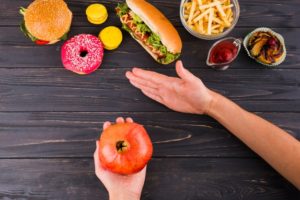Navratri is a time for festivities where we worship Goddess Durga, and some people do fasting as well. Many communities across India abstain from consuming alcohol, onion, garlic or non-vegetarian food during this time, and some restrict their diet even more severely during these nine days dedicated to Goddess Durga.
Although most people fast for spiritual purification at this time, there’s a scientific explanation to it as well. Navratri coincides with the changing seasons, a time when the body’s immunity is low and people are more likely to fall ill. Below are seven food that are allowed in fast –

Fasting food
1. Sabudana
Sabudana is an excellent source of carbohydrates which gives a much-needed energy boost during fasts. It also gives a cooling effect to the body and is easy to digest.
Though low in fat and protein, it can be used with other ingredients, such as milk and nuts, for making kheer, payasam, gruel or vegetables and peanuts for making sabudana khichdi. Control the fat and it can be a healthy option.
2. Singhara Atta
Water chestnut flour, also known as singhara atta, is prepared from dried, ground water chestnuts. Singhara ka Atta is a good source of minerals and vitamins. It is rich in vitamin B, and potassium. It also contains a number of antioxidants. The best way to eat singhara atta is to prepare rotis from it. You may even make dhoklas from singhara atta.
3. Dry Fruits
Dry fruits are a tiny nuggets loaded with tons of benefits. Almonds, pistachios, cashew nuts and kishmish are eaten during fasts to garnish sweets. You can eat a handful of nuts as a snack or for breakfast to have sustained energy throughout the day.
4. Makhana
Makhana is a very popular food during fasting. It is loaded with antioxidants and acts as an anti-ageing food by preventing white hair, wrinkles and premature ageing. Its high-fibre content avoids constipation, helps the body to flush out the waste and prevents the accumulation of toxins.
These nuts are low in saturated fats as well as sodium but high in magnesium and potassium which help in controlling high blood pressure, diabetes, palpitation and insomnia.
5. Dairy products
Dairy products are considered to be holy for any auspicious occasion. Low fat dairy can be consumed at any time of the day to give the protein needed for sustained energy. Milk protein takes a long time to digest and hence keeps the sugar levels stable. Have plain milk or buttermilk, sugar free fruit shakes, or make some paneer tikka to keep hunger pangs at bay.
6. Seeds
Flax seeds, sunflower seeds or chia seeds are all good options. Sprinkle them over some veggies or roll them into kuttu atta, these tiny seeds are healthy ways to keep your energy levels up.
7. Quinoa
Quinoa is a gluten-free edible seed that belongs to the same family as amaranth. It is native to South America but is even grown and available in India. It is prized for its high quality of proteins. You can use it as a substitute for rice and try a one pot meal with quinoa, sweet potatoes, coconut and nuts.
